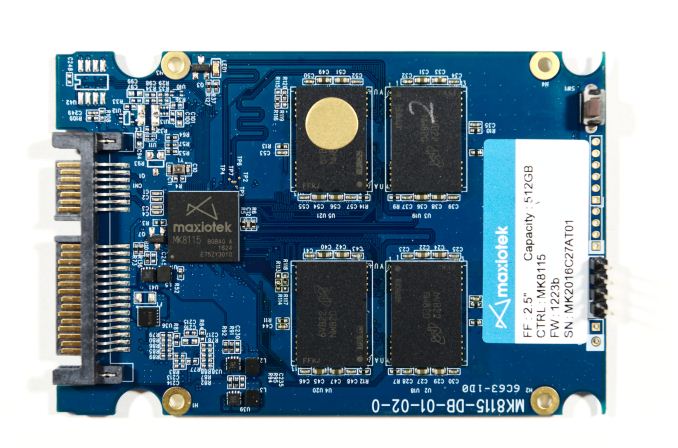Previewing Maxiotek's MK8115 SSD Controller: Can DRAM-less Drives Make The Cut?
by Billy Tallis on May 9, 2017 8:00 AM ESTFinal Words
The Maxiotek MK8115 is the first completely DRAM-less SSD platform we've tested in quite a while. DRAM-less SSDs haven't been a popular mainstream choice since SandForce drives were competitive, but they haven't entirely disappeared from the market either. Both Silicon Motion and Phison have continually offered DRAM-less controllers as part of their product lines, and they've been used for the entry-level SSDs of many brands. The problem with DRAM-less SSDs is that they are invariably afflicted with lower performance, and they seldom offer enough of a discount to make up for it.
Despite having SLC caching, plenty of overprovisioning and using 3D NAND, the Maxiotek MK8115 doesn't pull off any magic tricks. Its performance is usually substantially below that of mainstream SSDs with large DRAM caches. The MK8115 drive with MLC NAND is faster than the one with TLC, but still often slower than competing entry-level TLC drives. On average, the MK8115 with MLC or TLC is at least close to modern mainstream SSDs; it would be hobbled operating with a 3Gb/s SATA 2 link.
The big weakness of the MK8115 drives is the corner cases: when its performance drops, it gets *really* bad. Our test of steady-state random write performance on a full drive is not representative of any real-world client workload, but it is still a bit worrying to see the MK8115 drives outperformed by other low-end drives by a factor of five or ten. The ATTO disk benchmark revealed that the MK8115 delivers extremely poor performance for 512-byte transfers, with 512B reads giving less than 1% of the throughput from 1kB reads. Analyzing the latency patterns from our ATSB real-world workload tests shows that the MK8115 delivers reasonable average latency, but it is much more prone to outliers of unusually high latency.
The MK8115 controller is intended for use in client and consumer SSDs with entry-level market positions. Thus, the results from the sample with MLC NAND, while very useful for analyzing the controller itself, are unlikely to represent any real product. The slower TLC-based drives are what will actually be on the market, and what should be the primary indicator of how retail MK8115 drives will behave. Those products, starting with the ADATA Ultimate SU700, will offer SSD-like performance most of the time. They won't be fast enough to be a performance upgrade from any SSD that's only a few years old, but they'll still be much faster than a hard drive. The MK8115 also offers the usual power efficiency advantages of SSDs and 3D NAND, though drives like the Crucial MX300 are more efficient still despite running a DRAM cache.
More than any drive we've reviewed recently, the MK8115 platform needs to come with the caveat that it is not suitable for every workload. These drives are fine for light client workloads, but they don't do well when full and their random access performance is sub-par.
As the memory industry continues to experience a shortage of flash memory and as DRAM prices are climbing, now is the best possible time for DRAM-less drives to hit the market. They offer the best short-term prospect for lowering SSD prices or keeping them from growing too much. The supply constraints are forcing manufacturers to either raise SSD prices or compromise on performance. The MK8115 could be a reasonable option for products that are sacrificing performance, but only if the price savings are significant enough to matter. The ADATA SU700 is not yet widely available, but so far the pricing on the 120GB and 240GB models is not close to competitive. As the market shifts over the next several months it could end up as one of the cheapest options, or other factors may keep the Crucial MX300 on its throne as the best value SSD until 64+ layer 3D NAND starts to affect the market.











60 Comments
View All Comments
MajGenRelativity - Tuesday, May 9, 2017 - link
That might be a long way awayvladx - Tuesday, May 9, 2017 - link
You're gonna have to wait till mid-2019 for that.CheapSushi - Wednesday, May 10, 2017 - link
You'll get that most likely when QLC drives come out. But consider they'll be for bulk storage rather than general use.MajGenRelativity - Thursday, May 11, 2017 - link
YepHomeworldFound - Tuesday, May 9, 2017 - link
There's definitely some kind of manipulation occurring in the memory industry, it's happening with both DRAM and NAND.FH123 - Tuesday, May 9, 2017 - link
Let's see. JMicron SSD drives stalled (I had one). Two different USB drive enclosures, featuring JMicron chipsets, caused random data corruption for me and my colleague. The DVD / Blueray drives on my desktop randomly fail to show after boot. The chip they're hanging off of? JMicron. Will I consciously buy anything from this company or their offshoots? Nope. Their chips are ubiquitous and hard to avoid, but what trash they are.romrunning - Tuesday, May 9, 2017 - link
Don't forget the infamous JMicron "stutter" problem!vladx - Tuesday, May 9, 2017 - link
I have an ADATA SP600NS34 with JMicron JMF670H and it's a solid drive with 100% life remaining after 3TB written. No slowdowns or drive timeouts either.jabber - Tuesday, May 9, 2017 - link
I'm trying to hold off buying in any SSD drives at the moment. Prices have got silly compared to what I was paying a year ago for essentially a better product.romrunning - Tuesday, May 9, 2017 - link
So true on the pricing woes - I'm hoping there is more MLC capacity coming on soon.